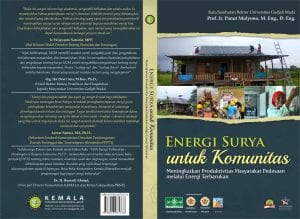 There is a very strong need for development in Indonesia to implement multidimensional considerations as the final target. Severe environmental degradation that is increasingly visible and felt is due to the partially implemented development model. Implementation of development that results in economic growth without regard to resource sustainability will threaten the future of the nation itself.
There is a very strong need for development in Indonesia to implement multidimensional considerations as the final target. Severe environmental degradation that is increasingly visible and felt is due to the partially implemented development model. Implementation of development that results in economic growth without regard to resource sustainability will threaten the future of the nation itself.
Another problem that arises is the practice of development that is not able to adequately understand the needs of the community. This happens because of the low involvement of the community in the planning process, decisions and implementation of various development programs. This often results in misleading development programs. Various corrective efforts on this kind of development model are continuously done, but efforts to capture grassroots needs are often unsuccessful. Insufficient ability and community participation and insufficient insight are the ends of this problem. Many meanings of community-based development are still interpreted narrowly and are considered to be the cause of large and ineffective cost consequences.
The book based on a multidisciplinary program run by “KEMALA”, which is an acronym for the Consortium for Independent and Sustainable Energy. This consortium is composed of:
- Institute for Research and Development of Human Resources – the Great Management of Nahdlatul Ulama (LAKPESDAM-PBNU), as leader of the Consortium,
- Gadjah Mada University Energy Study Center (PSE UGM),
- Center for People’s Economy Study at Gadjah Mada University (PSEK UGM), and
- Center for Civic Engagement and Studies (CCES).
This consortium was started in July 2016 to February 2018 by running a program entitled “Increasing Poor Household Income through Green Enterprises Supported by Renewable Energy” in one village in South Solok Regency, West Sumatra and two villages in Tanjung Jabung Timur District, Jambi.
The three villages have the same characteristics, namely:
- Not connected to the PLN electricity network,
- Having natural resources that have not been optimized to improve welfare; processed in a traditional/limited way,
- Limited public services and business development, among others due to the unavailability of adequate energy services,
- The average level of education of the population is not high.
The program is targeted to produce two outcomes, namely:
- Increasing socio-economic productivity and sustainable environmental quality and
- Increasing access to public facilities, joint business groups, and households, to renewable energy (in this program the Solar Power Plant – PLTS).
The outcome can be achieved by realizing at least four outputs, namely:
- Running a community learning center titled “Green Schools”,
- Ongoing integrated agricultural practices and green business groups (Cooperatives or Village-Owned Enterprises),
- The establishment of PLTS to facilitate households, public facilities, and joint business groups, and
- The operation of local organizations that can manage PLTS.
Meanwhile, readers from practitioners can use this book as a reference in approaching the community to better understand their needs and unique characteristics related to various renewable energy programs, especially PLTS. Also, this book provides a reference for practitioners in initiating a new renewable energy project with a comprehensive approach that is neatly designed.
![]()
![]()
![]()

